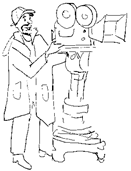Exercise 57. Choose the best option.
- The film producer is responsible for
a. finding the story and the film director.
b. casting.
c. the overall quality of the film and the finances.
- According to the text, the film producer does NOT do that during preproduction.
a. negotiating special effects
b. trying to make the film director like the script
c. discussing the final draft of the film
- The text suggests that in the production phase
a. the producer performs only administrative functions.
b. may act as an artist.
c. re-writes the script.
- The text says that in the post-production phase the producer
a. may have the film crew reshoot some scenes.
b. watches the whole film from beginning to end.
c. finds the distributor.
Exercise 58.Read the articleand make sure you know all the highlighted words.
Director of Photography
Giving a job description of a cinematographer is a bit difficult because the term “cinematographer” can apply to various jobs ranging from camera operator to director of photography. Most often, the term refers to the director of photography, or top cinematographer on a film, so let’s focus on that. 
Basically, cinematography means bringing a story to life visually. The word’s Greek roots are “kinema”(movement) and “graph” (writing). Bringing movement to screenwriter’s script requires more than simply shooting photos or video of a scene. The primary cinematographer, or director of photography, works with the film’s director to capture the underlying story in a way that will captivate the movie audience. Camera operators and cinematographers for specific scenes or types of scenes work to fulfill the overall vision.
The director of photography has a lot of specific responsibilities related to making a movie. In fact, the cinematographer’s job starts before a single frame of film is shot.
Preproduction
The cinematographer discusses the director’s vision for the film with him, both overall and scene by scene. Based on that, the cinematographer determines what’s needed for each scene, within budget, and hires the camera crew, arranges for equipment and buys film and supplies. The cinematographer also works with other departments, like sound and lighting, to coordinate production needs.
Production
The cinematographer coordinates the crew and works with the director to make sure each scene is set up and shot to match the director’s vision of the story. For each scene, the cinematographer decides on the best combination of cameras, filters and lenses, as well as where the cameras will be placed, what the lighting should be and when the scene will be shot. On large films, several cinematographers may oversee different camera set-ups. Others may serve as second-unit directors, shooting background or locations without the actors. The director of photography oversees them all, often also managing the photography budget.
Postproduction
The cinematographer works with the processing lab to make sure the film retains the color and mood that he and the director wanted. The cinematographer also reviews dailies, as well as the first and final print of the film. Being a critical eye and part of quality control is important throughout postproduction.
